Nigeria – Maritime Security, the Reality
By: Stephen Phelps
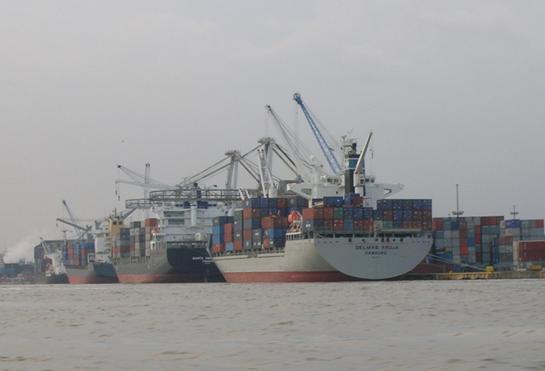
Introduction
The surge in piracy against international shipping off the Horn of Africa and the Indian Ocean has focussed the attention of the World’s media, international bodies and navies and drawn attention away from the troubled waters of the Gulf of Guinea on the far side of the continent.
The Gulf of Guinea is a target rich and high tempo operating environment, where incident rates outstrip those in East African waters and where attacks are often more violent.
The perception that West Africa is less hostile is partly due to under-reporting of incidents either deliberately or as a result of inefficiency in commercial or government security structures.
To give some perspective to the scale of the problem, in 2009 the IMB reported a total of 84 acts of piracy against international shipping along the West African coast from Guinea in the West to Angola in the South. However, as the graph in Figure 1 shows, in the case of Nigeria, the reality is significantly different. According to data gathered by the author, during the same period in Nigerian waters alone, a total of 108 criminal acts were committed against maritime targets (see Figure 1). These attacks targeted international shipping, the oil and gas industry and associated vessels and local marine traffic and commerce. The figures include criminal acts against ships in ports, coastal waters up to 100 miles offshore and also on navigable rivers serving inland ports in the Niger Delta (see figure 1 below).

Figure 1. Map showing major navigable rivers considered in this study
It might be argued that attacks against the oil and gas industry and local maritime traffic are not relevant. However, the perpetrators of these crimes are the same individuals and groups that attack international shipping. Furthermore, attacks on oilfield support vessels impact on IMO registered and internationally crewed vessels.

Graph 1. Comparison of reporting rates – Nigerian waters 2009
Background
Nigeria is the most populous country in Africa, with a 2005 World Bank estimate of the population sitting at 151million and it continues to grow. This huge population represents an enormous market. However, Nigeria’s economy is largely dependent on foreign trade and generates more than 90% of GDP through exports of oil and gas. This lack of economic diversity, coupled with higher wage opportunities in the oil and gas industry in particular has driven the workforce to abandon traditional industries and agriculture in favour of the new get-rich-quick opportunities in oil and gas. The urbanisation of the population has accelerated and traditional indigenous markets have shrunk. The net effect has been to drive imports up.
The above factors drive a massive volume of international trade, primarily through Nigeria’s main port of Lagos. This is likely to increase as Nigeria’s population continues to expand and particularly if new-found peace in the Niger Delta generates growing prosperity. At any one time there are estimated to be more than 200 vessels in and off the port, creating a target rich environment for criminals.
According to Nigerian Ports Authority statistics, in 2006 Nigeria imported 31,937,804 tons of goods while exporting 17,235,520 tons. The total throughput of 49,173,324 tons reflects an increase of almost 35 million tons in the decade since 1996. Four years later this figure has increased, but with a greater proportion being imported, reflecting both an increase in consumer demand, but also the impact of the militant insurgency in the Niger Delta on oil and gas production and exports.
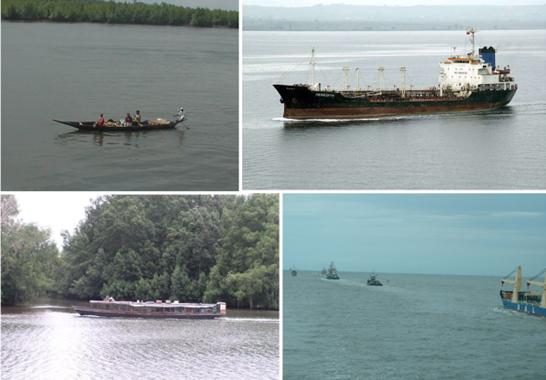
Nigerian Domestic Coastal and Riverine Traffic
In the Niger Delta, the threat is more complex due to the presence of both an active insurgency and organised crime on an industrial scale. These additional components of the threat are examined in more detail below. However, in this area the target array is also more diverse, including oilfield infrastructure and support vessels.
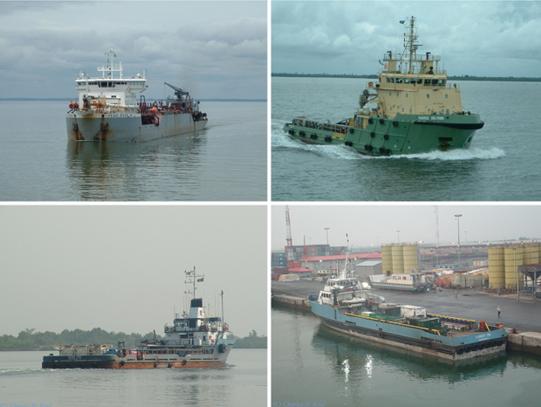
Oilfield Support Vessels
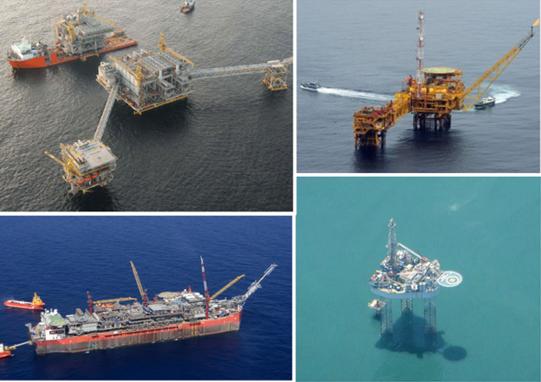
Oilfield Infrastructure
The Parameters and Characteristics of the Threat
The threat environment in Nigerian waters comprises of three major components and two enabling factors.
Severe inefficiency in port procedures and deficiencies in security forces performance coupled with weak governance and widely acknowledged corruption at all levels of government create a permissive environment for criminal elements. These inherent weaknesses are magnified by an almost four-year long insurgency in the Niger Delta, which currently is in abeyance – but only for as long as the newly appointed President Goodluck Jonathan can convince the youths of the region that the October 2009 amnesty program is sincere and viable.

Figure 2: Nigeria Maritime Security Threat Components
The figure above illustrates the overlap between the various threat components in the region, where for example a group of militants will also conduct organised criminal activity in the form of crude oil theft. They might also conduct criminal piracy or kidnap for ransom when they need to generate funding to support their other activities.
There are other intrinsic links between criminal and political actors reflecting the origins of the gangs, which in many cases were formed and armed by politicians to support their political ambitions on the advent of democracy in the country.
In Lagos Port and anchorage, criminal piracy is the primary threat. In the Niger Delta it is also a significant contributor to the overall levels of activity. Criminal piracy in the region is characterised by the following:
- Desire for monetary gain
- Boarding and robbery
- Low threshold for initiation of violence
- Attacks frequently involve use of firearms, edged weapons and blunt instruments
- Seasonal drivers of activity
- Poor or no response to alarms by security forces
Organised Crime is present throughout Nigerian waters. It comprises primarily of smuggling, which is prevalent in Lagos and the Bakassi Peninsula in the extreme east of Nigerian waters. The practice facilitates the illegal trading of everything from drugs, weapons and petroleum products to rice, wildlife and human beings. However, In the Niger Delta, organised crime is noteworthy primarily for the transportation and illegal export of massive volumes of stolen crude oil. According to one Nigerian Government figure, the volumes of crude oil stolen exceed 680 thousand barrels per day (mbpd), while an oil industry source recently quoted the figure to be close to one million barrels per day. The practice is facilitated by the insecurity that is endemic in the region and, according to some reports, significant levels of involvement by senior members of the Nigerian Armed Forces [i]
Militant activity is driven by a call for social and distributive justice for the people of the oil-producing states of the Niger Delta. It manifests primarily as attacks on the oil and gas industry and the Nigerian Security Forces in an attempt to undermine the nation’s economic base and demonstrate to Abuja that the people of the Niger Delta reject the authority of the Federal Government under current remunerative arrangements. Attacks on oilfield platforms and FPSOs as well as oilfield support and service vessels often involve the kidnapping of expatriates and sometimes significant violence against Nigerian crewmen.
Incident Rates and Targeting [ii]
The following tables and graphs are based on information gathered by the author. They illustrate a year on year increase in activity and demonstrate the range of targets that are attacked.

Table 1. Geographical Spread of Incidents in Nigerian Waters – 01 Jan 2007-20 Aug 2010 (S&I Solutions Data)
Table 1 shows a relatively steady rate of activity in the Lagos area indicating a ‘mature’ environment. However, following the introduction of a small boat movement curfew effective during the hours of darkness, activity in the Port area declined dramatically. In the Anchorage, activity continues, but at an apparently reduced rate. This apparent reduction in activity in the anchorage might be a reflection of a possible move by government to curtail reporting of security incidents. An oil industry source indicated that in January 2010 an agreement was reached between the government and the media and oil industries to reduce the reporting of such activity. If true, this may reflect the political expediency of demonstrating that the amnesty program is viable and effective. However, further east, in Rivers and Bayelsa States, two of the three states at the heart of the Niger Delta insurgency, there is an upward trend over time.

Graph 2. Cumulative monthly totals for attacks in Nigerian waters – 2007-2010 (S&I Solutions Data)
The graph shows that since the Niger Delta insurgency commenced in 2006 the problem of maritime criminal activity in Nigerian waters has escalated year-on-year until 2010, when the effects of the amnesty combined with a further reduction in reporting of incidents presents a much reduced figure for activity levels.

Table 2. Incident Characteristics – 01 Jan 2007-20 August 2010 (S&I Solutions Data)
Table 2 Shows that the majority of events culminate in a boarding, usually leading to robbery. Most attacks involve the use of firearms, although reporting often omits such detail.
Boarding and assaults on vessels are achieved through a number of means depending on the type of vessel being attacked and include:
- Gangway assault on berthed vessels
- Escalade – scaling anchor chains and mooring ropes
- Escalade – Use of grappling hooks on vessels both at anchor and underway
- Threat of / use of firearms and explosives to force vessels to stop
- Cross-decking onto vessels with a low freeboard
- Pulling alongside and threatening personnel with weapons to facilitate robbery
Nigerian waters are a target-rich environment. Table 3 summarises the types of vessels and platforms attacked over the period since 01 January 2007. It also shows that oilfield service and support vessels are the most likely to be attacked, followed by tankers and then local fishing or passenger vessels.

Table 3. Target Selection – 01 Jan 2007-30 April 2010 (S&I Solutions Data)
Table 3 shows that attacks against foreign flagged/operated vessels are the most numerous. However, attacks against Nigerian operated vessels and boats surged in 2009 – this may reflect improving data capture by the author, however, it is likely also to reflect a real increase in attacks on Nigerians in the marine environment.
Abduction and Kidnap
Mariners are rarely kidnapped in the Lagos Port or Anchorage. However, off the Niger Delta States it is an ever present problem, with both mariners and oil industry workers abducted for ransom or political leverage. Graph 3 illustrates the scale of the problem. In 2007 a total of 69 expatriates were abducted in the marine environment, 44 in 2008 and 42 in 2009. To date, in 2010 a minimum of 35 mariners are known to have been abducted in the offshore and riverine environments of the Niger Delta and a further minimum of 9 from neighbouring Cameroonian waters by probably Nigerian gangs.

Graph 3. Expatriate Kidnaps – 2007-09 (S&I Solutions Data)
The following table summarises known data for all casualty categories since 01 Jan 2007.

Table 4. Casualties – 01 Jan 2007-30 April 2010 (S&I Solutions Data)
It should be noted that the figures for abductions of Local Nationals (Nigerians) is probably lower than the true figure. Attacks against Nigerians often go unreported. Figures for casualties among members of the Nigerian Security Forces are also notoriously unreliable, being manipulated for propaganda purposes and sometimes simply to save face.
After the Federal Government awarded a full amnesty to Niger Delta militants on 04 October 2009, no expatriates were abducted in the Nigerian marine environment until 02 July when the BBC Palonia was attacked off Bonny Island. Since that date a total of 35 expatriates have been abducted at sea, the majority in the vicinity of Bonny.
Additionally, a growing problem has emerged in the waters off the Bakassi Peninsula in the extreme east of Nigeria’s coastline. The peninsula was Nigerian territory until 14 August 2008, when the area was ceded to Cameroon. Nine expatriates have been abducted in Bakassi waters since 01 January 2010. These incidents are not captured in the graphs and tables in this paper.
The following graph examines trends in the overall threat to both expatriate and Nigerian personnel.
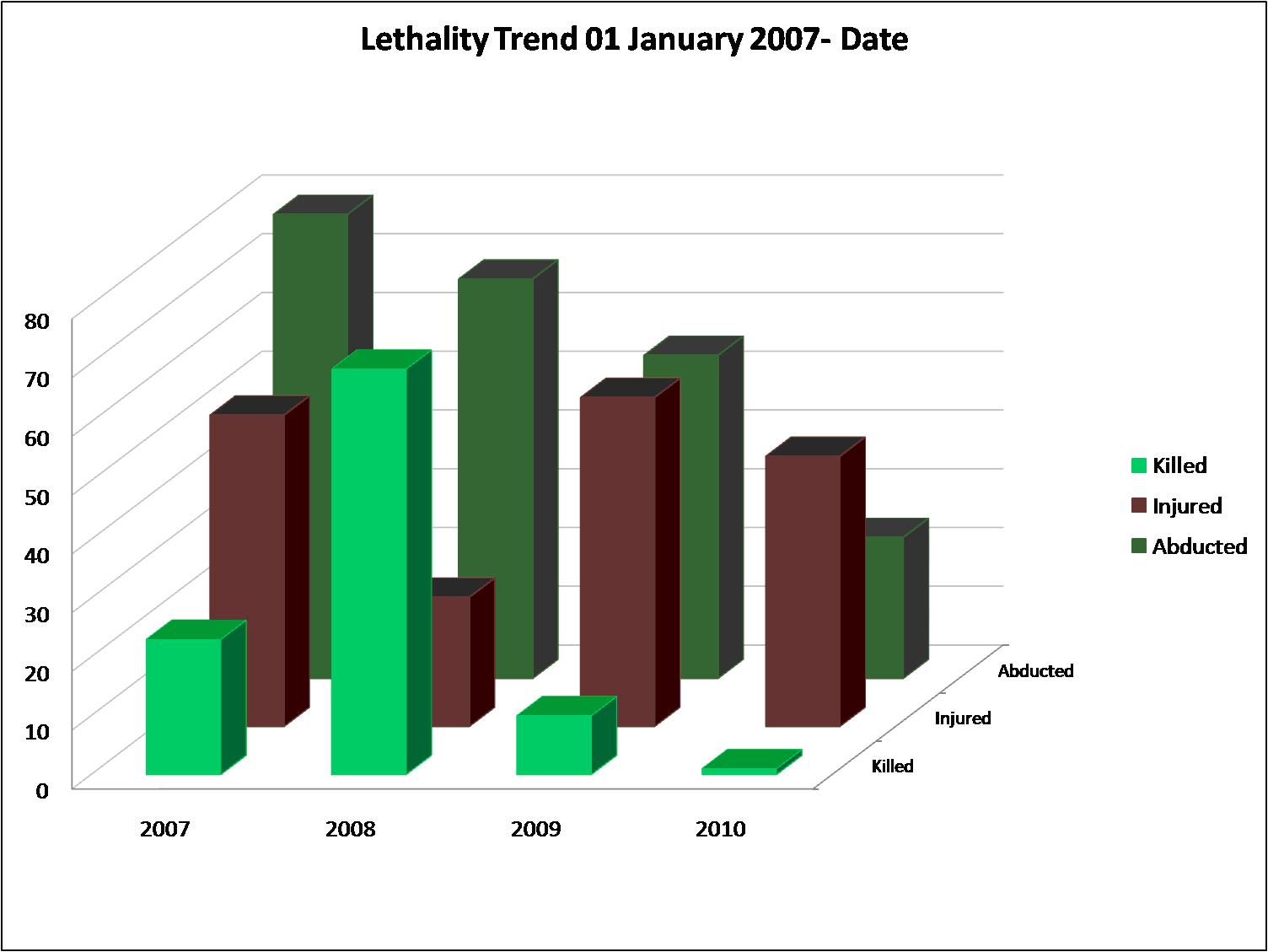
Graph 4. Threat to personnel – 2007-30 June 2010 (S&I Solutions Data)
The graph shows that the threat of kidnapping has steadily reduced, however, the recent monthly totals and activity patterns indicate that 2010 may reverse this general trend. Accompanying this trend, and not reflected in this graph, was a significant surge in kidnapping of Nigerian nationals onshore as criminal elements switched to softer targets in response to implementation of improved countermeasures to protect expatriates both at sea and onshore. The lethality of the environment diminished in 2009 following a spike in fatalities at sea in the previous year. Again, this is attributable to the hardening of facilities and an increasing awareness among mariners. Virtually all recorded fatalities occur in Niger Delta waters. Of the fatalities in 2008, only 1 was an expatriate. Twice as many foreigners were killed in 2007 and 2009. To date in 2010, no expatriates have been killed.
Note: Analysis is based on data from multiple sources including IMB and oil & gas / maritime company reports as well as anecdotal reporting from sources in Nigeria
The Response
More than once in the last three years, reports that Lloyds War Committee was considering declaring Nigerian waters a war zone focused the Nigerian Government on the challenge of ‘recapturing’ its territorial waters from the seemingly endless number of criminal gangs and militants that roamed freely, attacking and plundering vessels and platforms at will. The potential impact of such a declaration on the costs of insuring vessels trading in Nigerian ports and waters was not lost on the indigenous markets and pressure grew for action to be taken against piracy and other forms of maritime crime.
The Nigerian Navy was and remains in a parlous state, with a fleet and doctrine that was established for blue-water operations. It is under equipped and resourced and until the second half of 2009 was reportedly poorly trained for inshore and riverine security tasks. The few warships available to the fleet were poorly maintained and many were simply unseaworthy.
However, since late 2008 a procurement program has seen significant numbers of patrol craft introduced into service together with some focus on retraining the Nigerian Navy to protect the country’s Exclusive Economic Zone. This is a welcome departure from a focus on flag waving tours on the far side of the Atlantic.
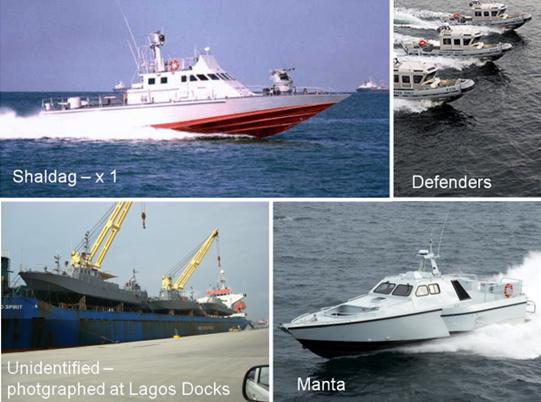
Nigeria Navy Patrol Craft
At the tactical level, at the end of 2009 the Lagos Port Authorities imposed a curfew on small boat movements during the hours of darkness, when most attacks inside the port occur. This has apparently been effective, with only two incidents reported inside the port itself since 01 January. However, incidents are still occurring in the anchorage. A similar ban on small boat movement has been imposed on the Bonny River, with some success, although local fishermen and passenger boat operators complain that the ban impacts on trade.
Perhaps indicative of the seriousness which the Nigerian Government attaches to the security of its major trading routes, the Nigerian Air Force has recently acquired two maritime patrol aircraft from the Italian company Alenia Aeronautica. These platforms will dramatically enhance the country’s ability to monitor its maritime environment. However, unless there is a significant uplift in surface response capability then the situational awareness these aircraft will generate will be squandered.
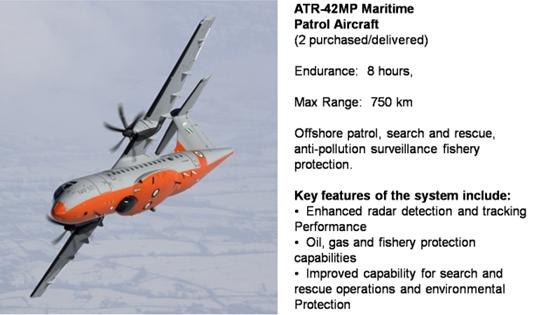
Maritime Patrol Aircraft
Nigeria has ambitions to form a separate Coast Guard service under the aegis of the Nigerian Maritime Administration and Safety Agency (NIMASA). However, the genesis of this new force is currently mired in political wrangling and resistance from the Navy, which possibly rightly feels that the establishment of a new force would dilute investment in the Navy and generate a weaker overall response as a result. The issue is driven also by a need to protect status and budgets. Of course, if allegations made by former militants of collusion between elements inside the Navy and oil bunkering gangs are true, the possibility exists that powerful actors close to the Navy may not wish to have another force involved in countering organised crime.
The US Africa Command (AFRICOM), which paradoxically is headquartered at Stuttgart, Germany, is striving to establish a permanent base in the Gulf of Guinea. However, the Nigerians are strongly opposed to the establishment of any foreign military presence on their soil, and the other littoral states share that position. Thus, the Command is reduced to delivering training and capacity enhancement to indigenous forces through consecutive presence tours by maritime forces.
Summary
Nigeria’s population continues to expand at a ferocious rate, sustaining a surge in international trade through the country’s ports. This will ensure that the density and variety of targets in Nigerian waters will remain high.
The statistics above clearly show that Nigerian waters are significantly more hostile in terms of lethality than the waters off Somalia and the Indian Ocean. Recent initiatives have reduced the rate and lethality of attacks – for now. However, the reduction is possibly no more than a hiatus, as former militants constantly threaten to return to the swamps and resume the insurgency in the face of the Federal Government’s inability to deliver on its side of the amnesty deal.
The security environment in Nigeria currently rests on a political fulcrum, and it could tip either way. Newly sworn-in President Goodluck Jonathan, a Niger Delta indigene, surprised both domestic and international audiences with his vigorous and focussed efforts to address the issues in the Niger Delta. The government rolled out a programme of retraining and reintegration of former militants in June although, as the situation off Bonny testifies, significant numbers remain recalcitrant. Unless there is substantial social development and investment in infrastructure in the region, the process will continue to hang on a thread.
The ambition to form a Coast Guard will likely continue to face political and institutional challenges, while the ambition of the Navy to meet the task it faces in the EEZ may not be up to the challenge without significant international investment in training and support.
However, the problem will not be solved with firepower and horsepower. As is the case in all regions around the World, the causes of piracy are to be found on shore – where the people that perpetrate the crimes live. While most of Nigeria’s population lives in poverty, the drivers of criminal activity will remain.
It is anticipated that at the end of the year, the figures in the tables and graphs for 2010 will show that Nigeria remains a very hostile environment for those that earn a living on the sea.
Stephen Phelps
Click on photo for LinkedIn profile
[i] http://www.nigeriacalabash.com/index.php/economy/446-ex-generals-fingered-as-crude-theft-worsens-680000-barrels-stolen-per-day-
[ii] All data have been collected by the author and include information from the IMB/IMO, oil and gas company reporting, shipping company reports and open source reporting in Nigerian and international media. Wherever possible, incident records have been corroborated.



excellent article steve.
I’m reading article on smartphone, well done MSR guys.
Thanks Spark. Will be reviewing and updating early in new year when 2010 figures are all in and captured.
Steve,this is well informed. Beautiful research!. You have been doing wonderful jobs.
Thanks Bayo. I am working on a review of 2010 and an update article – I hope to have this ready in about 3-4 weeks – other commitments considered.